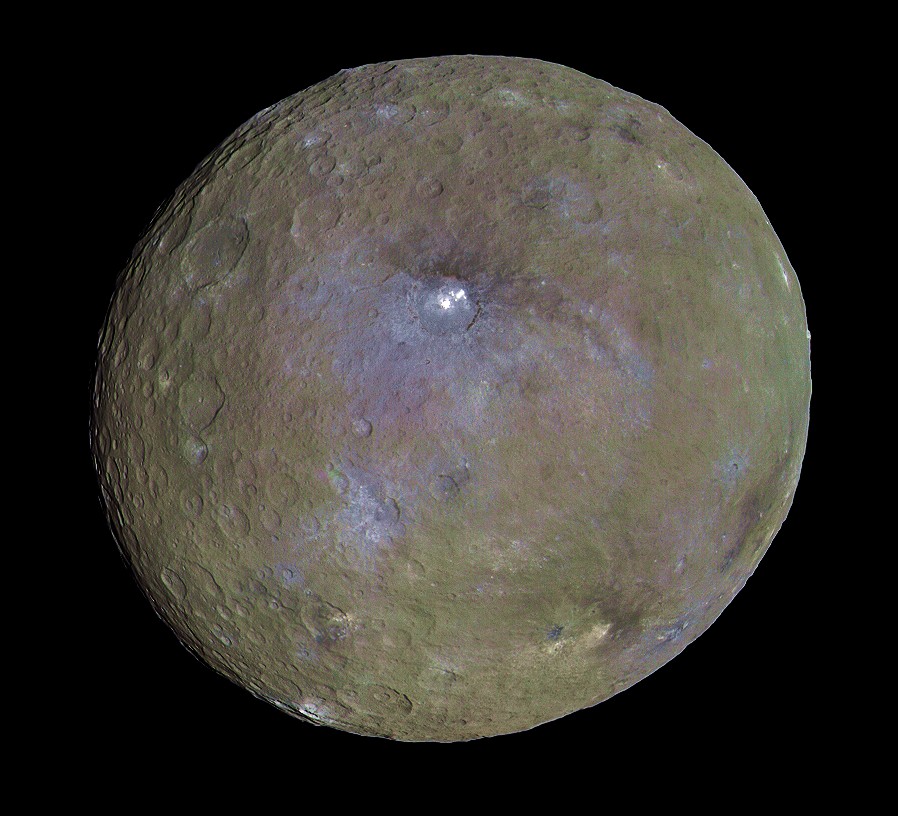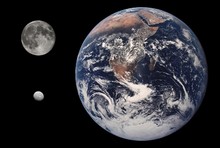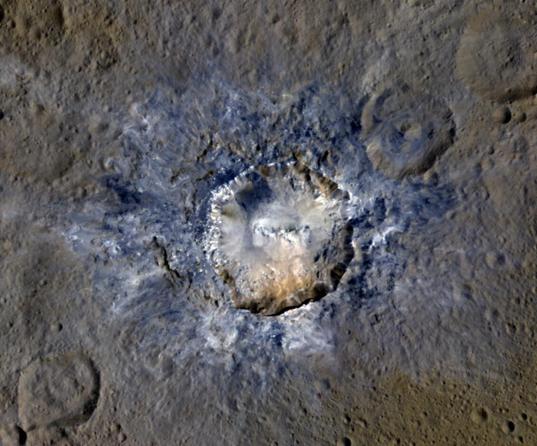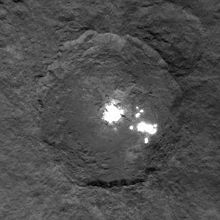
|
In this file:
Ceres, officially called "(1)Ceres", is the smallest known dwarf planet of the Solar system, and the largest asteroid of the asteroid belt between the orbits of Mars and Jupiter. Ceres was discovered in 1801 by Giuseppe Piazzi. It orbits around the sun in 4.6 years.
Its diameter is approximately 950 kilometers - it is not visible with the naked eye - and its mass constitutes one the third of the total mass of the asteroid belt bodies. Gravity on the surface of Ceres is estimated at 3 % of that of the Earth. The recent observations showed that it has a spherical form, whereas the smaller bodies of the ateroid belt have irregular shapes.

|
Above: compared sizes of
Ceres (bottom left), the Moon (top left). and the Earth (right).
The surface temperature of Ceres is relatively hot; it reaches a maximum of approximately -38 °C in daytime.
The observations indicate that Ceres results from a protoplanet, a planetary embryo that formed at the beginnings of the history of the solar system 4,57 billion years ago. The majority of the protoplanets were ejected from the solar system by Jupiter, or entered in collision between them forming some of the rocky planets such as the Earth and Mars.
Its obviously thin atmosphere contains water vapor. Its surface is primarily made up of a mixture of water ice and various mineral hydrates like carbonates or clay. Ceres has a rocky core. It may have a liquid water ocean, like Europa for example; which makes it a possible habitable place for extraterrestrial life.
Since December 8, NASA space probe Dawn flies over Ceres at 385 km of altitude. The probe is equipped with a camera, a visible and infrared light spectrometer, and a gamma rays and neutrons detector. These devices allow the examination of the shape and the composition of dwarf planet. It is this data and images which give us news of Ceres.
Ceres is big enough for gravity to draw it into a spherical shape. But it spins fast: once every 9.07 hours, which has distorted its shape into an ellipsoidal that's squashed pole to pole by about 7.5%. Its equatorial diameter is at most 966 km (600 miles), though a bit less elsewhere, but through the poles it's 892 km. Given its rotation period, this is pretty much exactly the expected shape - what geophysicists call hydrostatic equilibrium.
The overall density is 2.16 g/cm3, slightly higher than estimates from ground-based observations. Even so, it's far lower than that for a rocky body like the Moon (3.34 g/cm3). So either the interior of Ceres is full of holes (it's not) or there must be a lot of ice in there (most likely frozen water).
careful mapping of the gravity field reveals that the rock and ice aren't mixed together but instead have differentiated (separated) into a core and crust - though Ceres is not as completely stratified as is, say, Ganymede. Prior to Dawn's arrival, geophysicists were split on whether that would be the case. Park's team estimates that the crust has a thickness of near 190 km (120 miles), but it can't be pure water ice. Most likely it's strongly enriched with various salts.
Early in its history, Ceres had to be warm enough for the water to flow, and at some point this dwarf planet must have been covered with a deep, salty ocean. And maybe some of that ocean remains deep inside. After all, Ceres has more than 100 curious white spots - most associated with craters and most dramatically on the floor of Occator - and for now scientists are leaning toward salt deposits of some kind as the explanation for these.
Conceivably the impacts created enough heat to melt the ice locally and leave behind a salty residue. But other observations - like Dawn's imaging of hazes suspended above the surface and the detection of water vapor by ESA's Herschel space observatory - are building a strong case that there's a briny deep somewhere below the surface.
One of the color photographs of the surface of Ceres taken by the Dawn probe.

|
Haulani Crater in enhanced colors acquired by the Dawn probe during its third mapping orbit at an altitude of 1470 kilometers. The false colors highlight differences in composition or other properties. Blue is associated with geologically young material. The surrounding region was affected by the formation of the crater. The crater is 21 miles (34 kilometers) in diameter.

|
Picture of the Occator crater on Ceres with its "bright spots".

|
Two meteorites that separately crashed to Earth in 1998 contain ingredients for life: liquid water, and a mix of complex organic compounds such as hydrocarbons and amino acids.
The salt crystals in the meteorites carried microscopic traces of water that is believed to date back to the infancy of our solar system - about 4.5 billion years ago.
A detailed study of the chemical makeup within tiny blue and purple salt crystals sampled from these meteorites, which included results from X-ray experiments at the Department of Energy's Lawrence Berkeley National Laboratory (Berkeley Lab), also found evidence for the pair's past intermingling and likely parents. These include Ceres, a brown dwarf planet that is the largest object in the asteroid belt, and the asteroid Hebe, a major source of meteorites that fall on Earth.
The study was published on January 10, 2018, in the journal Science Advances.
David Kilcoyne, a scientist at Berkeley Lab's Advanced Light Source (ALS), which provided X-rays that were used to scan the samples' organic chemical components, including carbon, oxygen, and nitrogen, said that "It's like a fly in amber."
The rich deposits of organic remnants recovered from the meteorites do not provide any direct proof of life outside of Earth, but they are proof that space bodies can contain abundant organic matter also associated with liquid water, that is really crucial to the origin of life and the origin of complex organic compounds in space.
It also show a possibile way for organic matter to be passed from one host to another in space.
Queenie Chan, planetary scientist and postdoctoral research associate at The Open University in the U.K., the study's lead author, said:
"There is a great range of organic compounds within these meteorites, including a very primitive type of organics that likely represent the early solar system's organic composition."
"Combined with other evidence, the results support the idea that the organic matter originated from a water-rich, or previously water-rich parent body - an ocean world in the early solar system, possibly Ceres."
"Everything leads to the conclusion that the origin of life is really possible elsewhere."
The study: "Organic Matter in Extraterrestrial Water-Bearing Salt Crystals Indicates Ceres as an Organic-Rich Body", by Queenie H.S. Chan, Michael E. Zolensky, et al., in Science Advance, January 10, 2018.
When an important relief was detected on Ceres by the Dawn probe, some called it wrongly a "mysterious pyramid". It is in fact of a cryovolcano:
Sept. 1, 2016
NASA Discovers "Lonely Mountain" on Ceres Likely a Salty-Mud Cryovolcano
An isolated mountain near the equator of the dwarf planet Ceres resembles a volcanic dome, according to new observations from NASA's Dawn mission. Like the "Lonely Mountain" Erebor in J.R.R. Tolkien's mythology, Ahuna Mons on Ceres was once occupied by a dragon, but one that "breathed" ice, not fire. The mountain likely formed as a salty-mud volcano. Instead of molten rock, salty-mud volcanoes, or "cryovolcanoes," release frigid, salty water sometimes mixed with mud.
"Ahuna Mons is evidence of an unusual type of volcanism, involving salty water and mud, at work on Ceres," said Ottaviano Ruesch of NASA's Goddard Space Flight Center, Greenbelt, Maryland and the Universities Space Research Association. "Geologic activity was discussed and debated among scientists: now we finally have observations testifying to its occurrence."
Although the volcano is not active now, the team was surprised that it appears geologically recent. Young volcanism on an isolated dwarf planet is a surprise, as usually only planets, or satellites orbiting around them, have volcanism. Also, volcanic eruptions require bodies to be rocky, like Earth or Mars, or icy, like Saturn's moon Enceladus. Ceres is made of salts, muddy rocks and water ice: exotic and unexpected ingredients for volcanism. Ahuna Mons on Ceres indicates such physical and chemical limitations to volcanism are only apparent. As a consequence, volcanism might be more widespread than previously thought.
"The Ahuna Mons cryovolcano allows us to see inside Ceres," said Ruesch. "The same process might happen on other dwarf planets like Pluto." Ruesch is lead author of a paper on this research appearing September 2 in the journal Science.
The team used images and 3-D terrain maps from the Dawn mission to analyze the shape of Ahuna Mons. They compared features and models of known mountain-building processes on Earth and Mars to the features found on Ahuna Mons. Mountains form in a variety of ways, such as the collision of crustal plates, the impacts of asteroids, and the eruptions of volcanoes. Each process gives the mountains it creates distinctive features. For example, the collision of crustal plates produces long chains or ridges of mountains instead of just a single isolated mountain, while asteroid impact craters have central peaks. Scientists concluded that Ahuna Mons most closely resembles a volcanic dome. These form when thick molten material pierces the crust but doesn't explode or flow very far, instead squeezing up like toothpaste and building a bulge or dome on the surface.
According to the team, it's the combination of features that makes the case for a volcanic dome. For example, the summit of Ahuna Mons has cracks like those seen in volcanic domes when they expand. Also, the slopes have lines that resemble those formed by rockfalls, and the steep flanks surrounding the dome could be formed by piles of debris.
The mountain's appearance also indicates it is young on a geological timescale. Surface features on planets with little or no atmosphere like Ceres get eroded by asteroid and meteoroid impacts, and take on a soft, rounded appearance. However, Ahuna Mons is sharp, with fine features like the debris from rockfalls that should fade with time. Also, older surfaces have a heavily pockmarked appearance from the accumulation of many impacts, but Ahuna Mons has few craters. Furthermore, mountains tend to get broader as they erode and slump under gravity, but Ahuna Mons is narrow with steep slopes. Finally, surfaces tend to darken as they are exposed to radiation and meteoroid impacts in the space environment, but Ahuna Mons is brighter than its surroundings.
"We're confident that Ahuna Mons formed within the last billion years, and possibly within a few hundred million years," said Ruesch. This is relatively new geologically, given that our solar system is about 4.5 billion years old. A young volcano on Ceres is surprising because Ceres is a small world, with a diameter about the width of Texas, and small bodies like this should quickly lose the heat from their formation. "Ahuna Mons is telling us that Ceres still had enough heat to produce a relatively recent cryovolcano," Ruesch said.
Activity of ice volcanoes is found elsewhere in our solar system. For example, Saturn's moon Enceladus has fountains of water-ice particles streaming from cracks in the icy crust at its south pole. Enceladus is even smaller than Ceres; heat is generated inside it from flexing due to the gravitational pull of neighboring moons and Saturn. Ceres is an isolated world; there's no neighbor nearby to give it a significant gravitational tug.
"There is nothing quite like Ahuna Mons in the solar system," said Lucy McFadden of NASA Goddard, a co-author on the paper. "It's the first cryovolcano we've seen that was produced by a brine and clay mix." The solid worlds in our solar system form a continuum from heavier, denser materials closer to the sun, such as the rocky terrestrial planets, to less dense, more volatile materials farther out, such as the icy moons of the giant planets and the Kuiper Belt objects. "Ceres, which orbits between Mars and the gas giant Jupiter, is interesting because it appears to be a transition object - it's not completely rocky, but it's not an ice world either," said McFadden.
The team plans to use the visible and infrared mapping spectrometer on Dawn to determine the surface composition of Ahuna Mons. The spectrometer detects the unique signatures found in light reflected from minerals to identify them. Ceres has a couple more dome-like features in other locations, but they appear older as they are broader and more heavily pockmarked by craters. It's unknown if they are actually cryovolcanoes or if there is any connection between them and Ahuna Mons. It's also unknown if there is any link between Ahuna Mons and the mysterious bright regions seen in hundreds of places on Ceres. Finally, the team wants to learn if there is anything special about the location of Ahuna Mons.
The research was supported by the NASA Postdoctoral Program at NASA Goddard, administered by the Universities Space Research Association through a contract with NASA.
Dawn was launched Sept. 27, 2007. It is the first mission to visit a dwarf planet, and the first mission outside the Earth-moon system to orbit two distinct solar system targets. After orbiting Vesta for 14 months in 2011 and 2012, it arrived at Ceres on March 6, 2015. The mission is managed by NASA's Jet Propulsion Laboratory, Pasadena, California for NASA's Science Mission Directorate in Washington. Dawn is a project of the directorate's Discovery Program, managed by NASA's Marshall Space Flight Center in Huntsville, Alabama.
Bill Steigerwald
Source:
The brightest area on Ceres, located in the mysterious Occator Crater, has the highest concentration of carbonate minerals ever seen outside Earth, according to a new study from scientists on NASA's Dawn mission. The study, published online in the journal Nature, is one of two new papers about the makeup of Ceres.
"This is the first time we see this kind of material elsewhere in the solar system in such a large amount," said Maria Cristina De Sanctis, lead author and principal investigator of Dawn's visible and infrared mapping spectrometer. De Sanctis is based at the National Institute of Astrophysics, Rome.
At about 80 million years old, Occator is considered a young crater. It is 57 miles (92 kilometers) wide, with a central pit about 6 miles (10 kilometers) wide. A dome structure at the center, covered in highly reflective material, has radial and concentric fractures on and around it.
De Sanctis' study finds that the dominant mineral of this bright area is sodium carbonate, a kind of salt found on Earth in hydrothermal environments. This material appears to have come from inside Ceres, because an impacting asteroid could not have delivered it. The upwelling of this material suggests that temperatures inside Ceres are warmer than previously believed. Impact of an asteroid on Ceres may have helped bring this material up from below, but researchers think an internal process played a role as well.
More intriguingly, the results suggest that liquid water may have existed beneath the surface of Ceres in recent geological time. The salts could be remnants of an ocean, or localized bodies of water, that reached the surface and then froze millions of years ago.
"The minerals we have found at the Occator central bright area require alteration by water," De Sanctis said. "Carbonates support the idea that Ceres had interior hydrothermal activity, which pushed these materials to the surface within Occator."
The spacecraft's visible and infrared mapping spectrometer examines how various wavelengths of sunlight are reflected by the surface of Ceres. This allows scientists to identify minerals that are likely producing those signals. The new results come from the infrared mapping component, which examines Ceres in wavelengths of light too long for the eye to see.
Last year, in a Nature study, De Sanctis' team reported that the surface of Ceres contains ammoniated phyllosilicates, or clays containing ammonia. Because ammonia is abundant in the outer solar system, this finding introduced the idea that Ceres may have formed near the orbit of Neptune and migrated inward. Alternatively, Ceres may have formed closer to its current position between Mars and Jupiter, but with material accumulated from the outer solar system.
The new results also find ammonia-bearing salts -- ammonium chloride and/or ammonium bicarbonate -- in Occator Crater. The carbonate finding further reinforces Ceres' connection with icy worlds in the outer solar system. Ammonia, in addition to sodium carbonate and sodium bicarbonate found at Occator, has been detected in the plumes of Enceladus, an icy moon of Saturn known for its geysers erupting from fissures in its surface. Such materials make Ceres interesting for the study of astrobiology.
"We will need to research whether Ceres' many other bright areas also contain these carbonates," De Sanctis said.
A separate Nature study in 2015 by scientists with the Dawn framing camera team hypothesized that the bright areas contain a different kind of salt: magnesium sulfate. But the new findings suggest sodium carbonate is the more likely constituent.
"It's amazing how much we have been able to learn about Ceres' interior from Dawn's observations of chemical and geophysical properties. We expect more such discoveries as we mine this treasure trove of data," said Carol Raymond, deputy principal investigator for the Dawn mission, based at NASA's Jet Propulsion Laboratory, Pasadena, California.
Dawn science team members have also published a new study about the makeup of the outer layer of Ceres in Nature Geoscience, based on images from Dawn's framing camera. This study, led by Michael Bland of the U.S. Geological Survey, Flagstaff, Arizona, finds that most of Ceres' largest craters are more than 1 mile (2 kilometers) deep relative to surrounding terrain, meaning they have not deformed much over billions of years. These significant depths suggest that Ceres' subsurface is no more than 40 percent ice by volume, and the rest may be a mixture of rock and low-density materials such as salts or chemical compounds called clathrates. The appearance of a few shallow craters suggests that there could be variations in ice and rock content in the subsurface.
Source:
Comment:
The first images of Ceres by the Dawn probe in March 2016 revealed bright areas, called by some "unexplained luminous spots" on its surface. This caused many more or less eccentric theories: volcanic ice, salt, eruptions, traces of extraterrestrial activity?
A new study published in Nature magazine now indicates that the second proposal would be the correct one. Indeed, it reveals that these bright places contain in fact a variety of hydrated salts.
"The nature of the bright spots of Ceres lets think that this planet has a layer under the surface containing salted water ice", according to Andreas Nathues of the Max Planck Institute for Solar System Research, which carried out the study. Falls of meteorites could have lifted up the salted water to the surface where it would have sublimated under the rays of the Sun. "The most probable scenario is that the process of sublimation of frozen water begins after the mixture of salted ice and rock is broought to the surface by a penetrating impact through the insulating higher crust", the stufy says. Indeed, the approximately 130 bright spots almost all coincide with an impact crater. The most active area with the most numerous bright is located in the Occator crater, the largest one on the dwarf planet, measuring more than 90 km in diameter and 4 km of depth.